Abstract
The Heritage Band of the Midwest (HBM), also know as the “Bunny Band,” is an all-volunteer ensemble of musicians that gather once a year during Easter week for three days to record an album of lesser-known wind band music with a traditional 19th century instrumentation. The story surrounding the ensemble is told through a cast of four: a wealthy philanthropist and euphonium musician who dedicated much of his life to preserving wind band music, a professor who focused his career on researching and arranging lesser-known wind music of Europe, the band itself, and the generations of musicians who volunteered their time and talents. The storyline has repeated itself each year since 1974 as the musicians gather for the annual recording event. The catalyst for this initiative was the “Heritage of the March” recordings initiated by Robert “Bob” Hoe Jr. in the 1970s. This article documents the 41-year history of the Heritage Band of the Midwest, presents the findings of a survey of current and past musicians of the ensemble, and introduces The College Music Society’s (CMS) archive of 44 HBM albums (1974 to 2015) as part of the CMS Symposium’s online Audio Performance Archive.
Setting the Stage
Figure 1. “The Bunny Band," Living in Iowa, episode #1322, produced by Peter Tubbs, Iowa Public Television, 2003. Film provided courtesy of Iowa Public Television
About a month before Easter, a group of musicians mostly from the Midwest receive a package of music. The package contains arrangements of primarily European wind band music that has been researched and collected over the years by Professor George Foeller and restored or arranged for a typical 19th century, European wind band. On the Thursday evening before Easter, the musicians show up at the high school band room in the small Iowa town of Maquoketa to record an album of Foeller’s arrangements. No public performance; just the recording sessions, striving for a near-perfect production. The band room is transformed into a recording studio with its array of microphones, digital recording equipment, and a large green and red light in front of the conductor under the control of the recording engineer. Over three days, with the conductor having a metronome in one hand and a baton in the other, the ensemble works down through the varied wind music, measure by measure, until, come Saturday noon, the music has been recorded in multiple takes. Finally, over the ensuing year a master is prepared from the many takes recorded on that Easter weekend to create the final album for the year.1
This event might not seem remarkable were it not that it has taken place annually over some forty years with a group of dedicated, volunteer musicians, leaving a unique legacy of 40 or more albums of little-known, international wind band music.With the publication of this article, The College Music Society (CMS) makes available for the first time some 44 HBM albums (1974 to 2015) as part of the CMS Symposium’s online Audio Performance Archive.2
The ensemble has recorded under various names including Heritage of the March, Foeller’s Illinois State Alums & Friends (FISAF) Band, the Heritage Band of the Midwest (HBM), and more affectionately, the “Easter Bunnies” or the “Bunny Band.” The acronym HBM will refer to the ensemble in its various renderings throughout this article.
The story of the Heritage Band of the Midwest will be told through a cast of four: the philanthropist, the professor, the band, and the musicians. The wealthy philanthropist and euphonium player who dedicated much of his life to performing and preserving wind band music; the professor who dedicated his career to researching and arranging little-known wind music of Europe, especially Austro-Hungarian band music; the HBM band itself; and the generations of volunteer wind musicians who donated their time and talent. The final section will describe the contents of the newly established CMS Audio Archive of this treasure trove of Heritage Band of the Midwest recordings.
The Philanthropist: Robert “Bob” Hoe Jr. (Robert Hoe V)
When LP records first emerged there were few commercial recordings of wind band music. Most notable is the Frederick Fennell series under the Mercury Label of recordings of the Eastman Wind Ensemble..3 The first recordings appeared in 1953 and continued into the 1960s with 24 LP albums.4 During the same era as the Fennell recordings, a businessman and keen euphonium player was looking for ensembles to fill his appetite for playing band music, especially march music. Robert “Bob” Hoe was a fifth generation member of the Hoe family and was named after his great-great grandfather who in the early 1800s invented the Hoe rotary press, designed for printing newspapers.5 Past generations of Robert Hoe’s used the family’s wealth for philanthropy and for collecting art and books. Bob used his wealth to collect recordings and music when he wasn’t running his chain of bowling alleys in New York. Arthur Bradley in his book On and Off the Bandstand, sketched this view of Hoe’s expanding music activities in the chapter entitled “Heritage of the March”:
Comfortably fixed, semi-retired, and a bit of a band freak, he took it upon himself to bring back the march. With no more than his personal collection of sheet music and support from a few like-minded friends and acquaintances, Hoe started his rejuvenation project in the early 1970s. His stated objectives were to examine and correlate the literature, encourage and inform teachers, and challenge a new generation of music students and their directors to re-establish the march as a viable art form. He carried out voluminous correspondence, coordinated all activities, and paid the bills.6
Quite simply, Hoe found himself frustrated for the lack of wind band recordings. Jay Kahn, a longtime member of the HBM ensemble, elaborated on Hoe’s frustrations. “Bob could not understand why such a small selection of marches was being repeatedly recorded by bands worldwide, while, through his travels and contacts, he had become aware of a vast untapped reservoir of ‘miniature masterpieces’ that was being virtually ignored.” Moreover, Kahn emphasized, “he was especially concerned with the spread of misinformation regarding march interpretation, and the almost complete lack of information on march composers.”7 Motivated to improve upon the situation, Hoe initiated his own recording series, The “Heritage of the March” project. Hoe intended to “…record every march ever written (both good and bad),” Kahn shared, and “…accurately document the biographies of the composers who contributed to the heritage of the band.”8
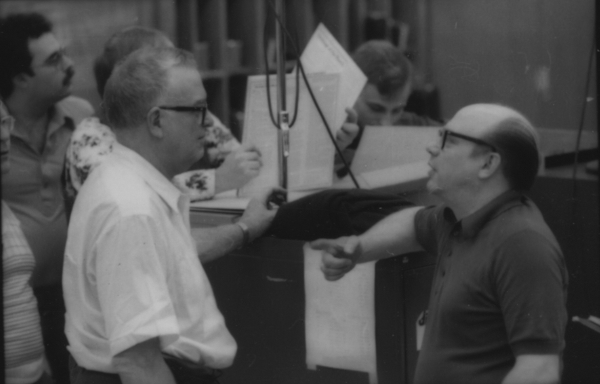
Figure 2a. Robert “Bob” Hoe with Professor George Foeller during a rehearsal with the Heritage Band of the Midwest (also known as the FISAF or “Bunny Band”) at the Fairbury (Ilinois) High School in 1978. Behind Bob Hoe is Mark DalPazzo who still plays with the band (Photo from the library of George Foeller).
The LP albums for the Heritage of the March project began with the U.S. Navy Band. In 1973, Hoe’s march project “really got moving,” Bradley reports, “when Hoe persuaded Don Stauffer, director of the U.S. Navy Band, to undertake a mammoth series of recording sessions.”9 All told, 15 LPs were produced from the Navy Band recordings. From the Navy Band, Hoe moved on to recordings with other military bands and university bands. Among the university bands were Tennessee Tech, Southeast Oklahoma University, Northeast Louisiana University, Central Methodist College, and George Foeller’s Illinois State University (ISU) band. The ISU band evolved into the volunteer band referred to by Bob Hoe as the “Illinois State Alums” or “Easter Bunnies.”10
As the online Heritage Encyclopedia of Band Music (HEBM) notes, Bob Hoe sought to “document and preserve lesser-known band works and to present biographical information on composers about whom the public knew little or nothing.”11 Many of the recordings featured two composers, one American on side A and a European composer on the flip side of the LP. Intermixed were various themed recordings and Sousa collections. Included with the recordings along with marches were gallops, waltzes, overtures, and various transcriptions.
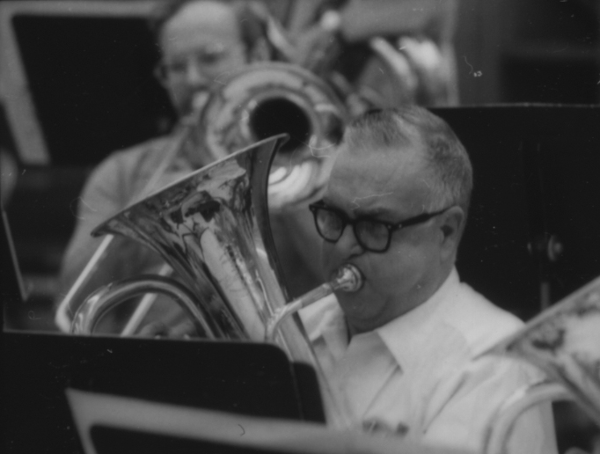
Figure 2b. Bob Hoe playing euphonium with the HBM ensemble in Fairbury, Illinois, in 1978 (Photo from the library of George Foeller).
One must credit to Bob Hoe not only his recordings but the bibliographic material on composers he included with the albums along with the enthusiasm he engendered worldwide among others who appreciated wind band music. Hoe published a newsletter from 1975 until his death to communicate in his own unique, no-holds-barred style, with his following or the “clan” as they were known. “That abrasive clan letter prose, stream-of-consciousness style, self-indulgence, and impatience with weak commitment,” Bradley writes, “take a little getting used to.”12
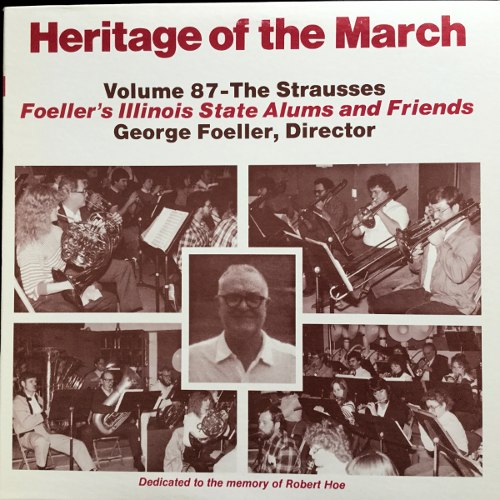
Figure 2c. The album cover from Volume 87 of the Robert “Bob” Hoe “Heritage of the March” series with the Heritage Band of the Midwest . The album was dedicated to Robert “Bob” Hoe, shown in the center of the album, and produced after his death.
The recordings continued up until his death in 1983 with some 3000 works for band. After Hoe’s death, his family and music colleagues continued mastering the remaining tape recordings to LPs and promoting his work through the Robert Hoe Foundation based in his hometown of Poughkeepsie, NY. The three volume, Heritage Encyclopedia of Band Music13 (HEBM), published posthumously by the Hoe Foundation, indicates that the Hoe Heritage series consisted of 263 LP recordings. Typically, some 2000 copies of an LP album were pressed and all of the recordings were distributed without cost to those who requested them. The HEBM is now an online, searchable resource for band music and composer biographies. A complete list is available on the online HEBM website under the heading, “The Hoe Heritage Series of LP Recordings.”14 The HEBM site also includes Robert Hoe recordings among its encyclopedia of band music. The University of Maryland also has digital archives of Hoe’s recordings and newsletters.15 Bradley’s On and Off the Bandstand16 offers more detail on Hoe’s project including information regarding bands like Foeller’s and the role these bands played in contributing to Hoe’s voluminous “Heritage of the March” collection of wind band music.
The Professor and Dirigent: George Foeller
George Foeller is Emeritus Professor of Music at Illinois State University. Prior to coming to ISU, Professor Foeller directed bands and taught instrumental music in the public schools in the states of Connecticut and Texas.17 Early in his career he was motivated, much like Bob Hoe, to find little known wind band music to expand the repertoire of his student ensembles. He was especially interested in the band music and the style of European composers and bands.
From Foeller’s research and travels he began to build a library of wind music and he arranged many scores to fit present-day band instrumentation. Foeller “began uncovering these marches by visiting the state libraries of Eastern Europe even before the fall of the iron curtain.”18 From his research, Foeller has written several articles for various international music organizations, contributed to the Heritage Encyclopedia of Band Music and several Austrian publications, and co-authored Bands of the Austro-Hungarian Empire with Werner Probst.19
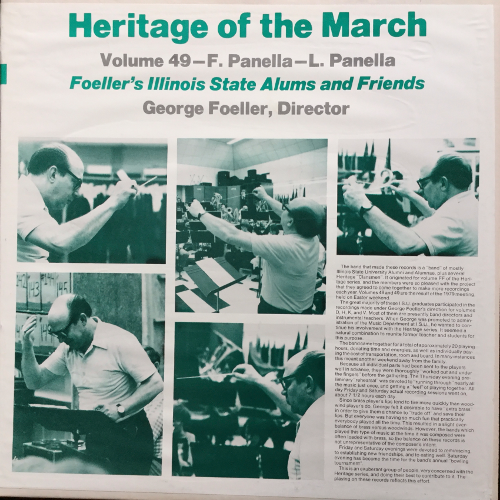
Figure 3a. The album cover from Volume 49 of the “Heritage of the March” series the Heritage Band of the Midwest (also know as the FISAF or “Bunny Band”) under the direction of Professor George Foeller.
The network of the “Hoe clan” brought George Foeller and Bob Hoe together through their shared appreciation of, and curiosity about European band music. Among those band authorities Hoe considered his equal, according to Bradley, was “Professor George Foeller, who took Illinois State students to Europe each summer to search for obscure band music.”20 As Foeller related, he “learned of Hoe’s LPs of the Navy Band and wrote to him. After that there were constant letters, some phone calls, and a few visits at his home in Poughkeepsie.”21
When Foeller stepped down as director of ISU bands in 1978, former students and fellow musicians—many who had become school band directors and freelance musicians in the state of Illinois and throughout the Midwest—encouraged Foeller to continue the annual recording sessions. The best time for the musicians to gather for a few days each year was the time leading into Easter weekend. For that reason, the new all-volunteer ensemble was formed to continue the tradition of recordings. While formally the complete series of the band’s recordings is known as the Heritage Band of the Midwest (HBM), the band is affectionately known as the “Bunny Band” or “Foeller’s Illinois State Alumni & Friends” (FISAF). The HBM, according to Kahn, is “the only one of the bands to make recordings for [Hoe’s] original series” and then to continue “to soldier on with the project as Bob originally envisioned it.”22
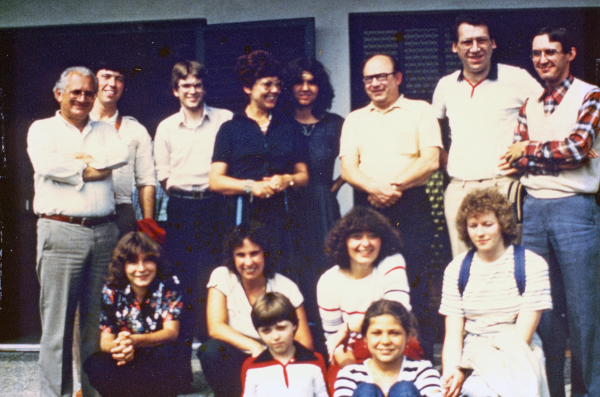
Figure 3b. Students with Professor Foeller on their 1982 travels to Europe researching band music. Photo taken in the town of Feldbach, Austria. Foeller is to the back center with glasses; the town burgermeister is on the far left; their host, the Brixel family are shown with their children in the foreground; and the student on the far right is the student, John Fesler. John played with the HBM until his death in 2010 (Photo from the library of George Foeller)
Foeller recorded 12 LP albums as part of Hoe’s Heritage of the March series. Those recordings are included in the CMS Symposium Audio Archives from 1974 to 1983. From 1974 to 1977 the recordings featured the Illinois State University band with Foeller as director. Following a path of Foeller’s students, many now high school band directors, the HBM ensemble moved its annual sessions in 1978 to Fairbury High School (Illinois). In 1985 the recording sessions moved to Chillicothe High School (Illinois). And, in 2000, the recording sessions were moved to Iowa and the Maquoketa High School where it continues to hold its annual recording sessions. The recordings which started as LP records, migrated to cassette recordings, and then to CD discs.23 Two albums of selections from past HBM recordings were created in 2009 for iTunes and Amazon digital distribution, but were withdrawn in 2014 because of the distribution fees.
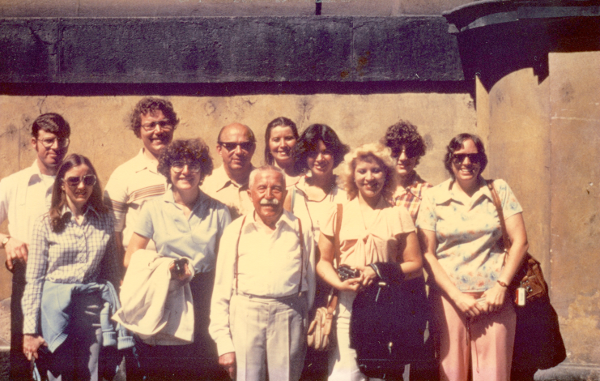
Figure 3c. Another photo from the student travels in 1979. This is taken in Prague, behind the Iron Curtain at this time. Shown are Foeller (3rd from the left on back row) and Dr. Miroslav Blaha on the front row. Dr. Blaha helped Foeller with researching many Czech composers and translations. Two notable students on the back row from the left are Jay Kahn who continues to play in the band and Dan Deitrich who played for many years (Photo from the library of George Foeller).
According to Foeller, “Bob [Hoe] played on all the recordings starting with the first Fairbury session, but he did not play on the very last one.”24 When old-timers of Foeller’s band gather they have many stories to share of the eccentricities of Bob Hoe. He had his own notions as to how band music, especially the marches, were to be played and he didn’t hesitate to share his opinions and interpretations. The last two of the Heritage of the March LPs (Volumes 87 and 88 in the Hoe series) produced with the HBM band, known at this time as the FISAF band, were made after Hoe’s death in 1983 with Volume 87 dedicated to the memory of Robert “Bob" Hoe, Jr.
The Band
The HBM, under its several appellations from the Illinois State University Band, to “Foeller’s Illinois State Alums and Friends” or FISAF, to the “Bunny Band,” consists of some 40 volunteer musicians under the direction of Professor Foeller. The instrumentation of the Heritage Band of the Midwest closely resembles that of a town or military band of the late 1800s to create a sound fairly typical for that time.25 Clarinets and flutes augment the basic brass sound; double reeds and saxophones are absent; percussion is minimal. For most of the recordings the instrumentation includes flutes & piccolo, B♭ and E♭ clarinets, horns, flugelhorns, trumpets, trombones, euphoniums, tubas, and percussion. As one might expect from an all volunteer ensemble, achieving a balanced instrumentation for the once-a-year recording session has always been a challenge. This is especially so with the woodwinds. A perusal of the album jackets from the HBM archives shows that clarinets and flutes were abundant in the earlier years and gradually thinned in the more recent recordings. At various times, additional instrumentation has been added as the music demanded. The earlier recordings up until about 1996 often used additional woodwinds, e.g., oboe, bass clarinet, or bassoon.
Among musicians of note, Himie Voxman of the University of Iowa played clarinet, and Bob Hoe, played euphonium on several of the albums. Foeller related that when Hoe first came to the Fairbury, Illinois, HBM recording sessions, he was concerned that the band had good lead trumpets so he invited band directors, Keith House of Central Methodist College, Missouri, and Bill Roosa, Allegany High School, New York. These directors also encouraged some of their best students to come along for the recordings, students who continued to play long after their band directors ceased to participate in the HBM ensemble.26
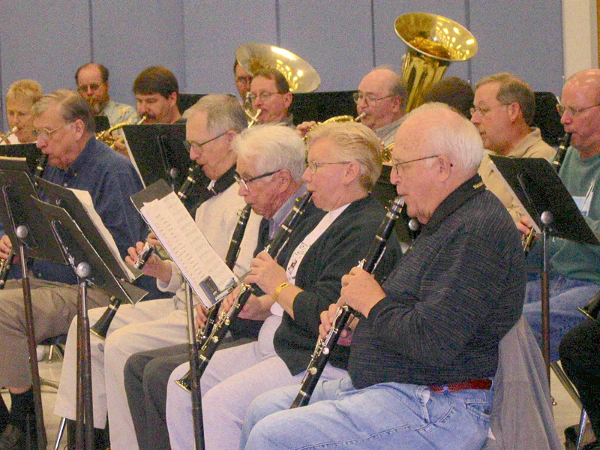
Figure 4a. The Heritage Band of the Midwest (The “Bunny Band”) in its 2004 recording session. Clarinets are left to right: Charles DCamp, Bob Kremenak, Dr. Himie Voxman, Judy Mathieson, and Jim Mougey (Photo used with permission from the Maquoketa Sentinel-Press).
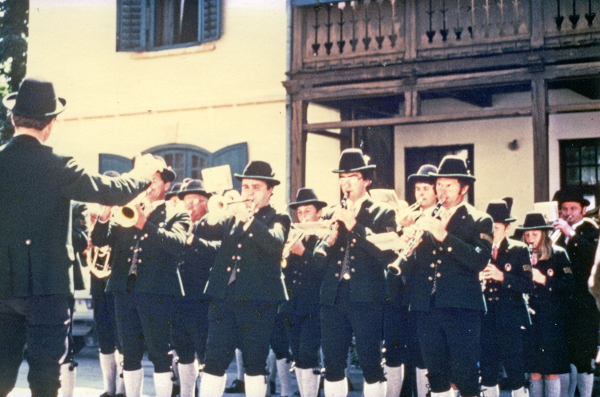
Figure 4b. The Pürgg, Austria, town band with director Dr. Wolfgang Suppan and instrumentation typical of town bands and the HBM ensemble (Photo from the library of George Foeller and taken on his student tour of 1979).
The Musicians
The heart and pulse of this project, whether it be the Hoe “clan” or George’s FISAF Bunny Band, is the pure passion of performing and the sense of community that a volunteer ensemble engenders. To gain a better understanding of the musicians who have participated over the years with the Heritage Band of the Midwest, a survey was conducted in 2015 using an online survey service, “Hosted Survey.”27
Survey items included information about the musicians’ music background: instruments played, their musical training, music and work experience, and the variety of ensembles they have participated in. Other survey items focused specifically on the HBM experience: number of years they have played in the band, travel distance to recording sessions, number of years participating in the ensemble, and the era in which they had participated. Items on the survey also asked the musicians to reflect on their experiences with the band. The survey was sent to 108 musicians for whom email addresses were available. Thirty-eight (38) musicians responded to the survey.
Music background. Based on the survey data, a typical musician in the HBM can be characterized as follows: he or she has more than 25 years of performance experience in a variety of ensembles; an undergraduate or graduate training in music; a professional career in music in some role—most likely a music educator; and was willing to drive 160 miles or more to the annual recording sessions.
Specifically, the data show that 24 of the musicians had 25 years or more of playing experience; the remainder: 16-24 years (2), 10-16 years (7), 5-9 years (4), 1-4 years (4). The extent of music training included: 6 with secondary school and private study;, 15 with undergraduate music training;, 10 with graduate music training;, and 7 with training beyond graduate school. When asked if they worked in some professional music capacity, 50% said yes, 26% indicated yes, but had retired, and 24% indicated no. Those that did not work in music were from diverse backgrounds: a veterinarian, a banker, a teacher, a machine operator, an engineer, a farmer, an electrician, an information technologist, a county government administrator, and a railroad machinist-electrician. Those 76% working in music professions currently or retired included secondary-middle school music directors (11), elementary music teachers (4), college music professors (4), studio musicians/private music teachers (6), music business professionals (3), and an organist (1).
The respondents were asked “what other ensembles do you play in?” Thirty one (31) indicated community bands. Twelve (12) perform in various wind ensembles and ten (10) in symphony orchestras. Others noted: jazz, big, and swing bands (14), military bands (3), various wind ensembles (4) and brass ensembles (12), German-polka bands (3), and choral/church groups (7).
Heritage Band Experience
The distribution of respondents provided a balanced representation of participation over the 40-plus-year span of the ensemble. Twenty-one (58%) of the respondents were currently active in the HBM. When asked how many non-consecutive years they had played in the HBM the results were as follows: 13.2 years on average, the median or midpoint was 8.5 years, and the range was 1 to 40 years. What was the farthest they had driven for an annual HBM recording session? The average was 176 miles, the midpoint was 160 miles, and the range was 3 to 860 miles.
All instruments within the ensemble were represented with some musicians having played multiple instruments: Flute/Piccolo (9), Clarinet (9), Bassoon (1), Trumpet (2), Flugelhorn (3), Horn (4), Euphonium (4), Trombone (6), Tuba (1), and Percussion (4).
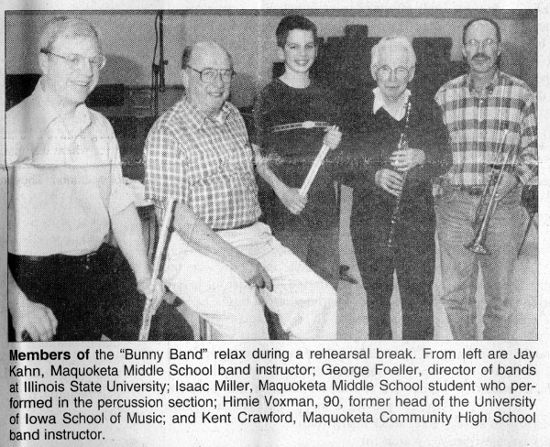
Figure 5. From a Maquoketa Sentinel-Press article, August 1st 2001, showing Himie Voxman with the Director, George Foeller, and the local Maquoketa players. Notable is the diverse age of the band members (Photo used with permission from the Maquoketa Sentinel-Press).
Reflections on the Heritage Band Experience
Two questions addressed the perceived music ability of the musicians in the ensemble and the difficulty of the music. On a scale of 1 (definitely amateur) to 5 (definitely professional ability) the responses were skewed toward a professional ability: 0% (1), 2.8% (2), 13.9% (3), 52.85 (4), 30.6% (5). To the question, “how would you rate the difficulty of the music,” the responses where skewed toward moderately (3) to very challenging (5) music repertoire: 0% (1, not challenging at all), 8.33% (2), 30.6% (3), 38.9% (4), 22.2% (5).
Several questions were designed to elicit insight into what motivated the musicians to prepare for and participate in a three-day, intensive recording session during the Easter holiday season for no remuneration. The responses that follow were categorized based on the author’s aggregation of the comments. Further, the responses were modestly edited for brevity and to fit the sentence flow; the intent and word choice of the respondents was never altered. The first question to this end was: “What was the one most compelling reason you played or play in the Bunny Band?” Responses can be generally categorized as the following reasons (the number of comments in each category noted in parentheses):
1. Enjoyment and opportunity to play (11): Several noted the enjoyment of the music, the love of playing with others, and the fellowship. “The totally enjoyable experience of making great music with a group of dedicated musicians.” As one noted, “for three days each year I don’t have to worry about anything else than playing my part.”
2. Preserve and appreciate history (11): The importance of preservation was emphasized through comments such as the importance of “participation in an ongoing project that has validity,” and the need “to have a professional level archive of music that would otherwise be lost.
3. Music and musicianship (8): Comments stressed the “high performance standard,” participating with “such excellence and precision,” and the “exposure to new literature that [one] would otherwise never experience.” “It is a fun challenge,” notes one musician, “to aim for the perfect recording alongside such great musicians; quite an honor to be included in the group.” From a more personal experience one wrote: “Himie Voxman encouraged me to play [in the HBM] if I ever got the chance. I studied with Mr. Voxman for about 10 years, so when he thought I should do something, I took the suggestion seriously.”
4. Friendship and camaraderie (8): This was expressed through comments such as “to meet with great folks,” “spending time with the other musicians and seeing former college friends,” and “excellent musicians who have become friends.”
5. Working under the director, George Foeller (4): As several noted, the chance to play under “George,” “Mr. Foeller,” or the “Dirigent.”
The next question in this set probed their experience: “If someone asked you why you volunteered several days out of a year for a Bunny Band recording session, what would you say?” Their responses can be gathered into two categories equally:
1. For the music (16): A sampling of comments included “to meet with great folks to play great music and preserve history,” “the privilege to make and archive music,” “the high performance standard and stylistic insights of the director,” “the music deserves to be remembered,” and the “tremendous sense of having accomplished something important.”
2. For the enjoyment and camaraderie (16): A shared sense of the enjoyment is captured in these reflections: “one of the most rewarding things I do all year,” enjoying “the comradeship both musically and socially,” and the “pure pleasure to perform with other professionals from around the country and learn new repertoire.” As one musician shared, “I have developed friends in the band that I really enjoy seeing each year; if I pay attention, I usually learn something.” And for a nice coda, “It is just plain fun”!
The third question in this set asked “What was the biggest challenge you found playing in the Bunny Band?” Here the responses were quite varied with more detail than one could reasonably share in this article here. The more frequent contributions fit under (1) recording and performance challenges and (2) mental and physical challenges.
1. Recording and performance challenges (16)
Errors (7): The intensity of the recording sessions over three days shows through these comments: “Being able to accurately play the music,” “staying focused through many re-takes to avoid errors,” “admitting to making a mistake as soon as it happened so not to ruin the whole take” and “playing without fear of being ‘the one’ who cracks a note.” During recording a large red and green light sits in front of the conductor and is wired to the recording engineer in the control room. Hence, as one respondent noted, a heightened anticipation waiting for the lighted verdict and “having patience with the red light.”
Music preparation (7): Each year the musicians receive the music a good month in advance. Challenges include: “having my music prepared in order not to bring the playing level of the band down,” “meeting the musical standard necessary to produce what will hopefully become a reference recording,” and “the challenge to individually come together, fit my part into the ensemble and be to ‘perfect’ for the entire session.”
Tuning (2): The challenge here is understandably “staying in tune throughout the recording session.”
2. Mental and physical challenges (12): Many varied thoughts shared in this category. A sample includes: “trying to stay focused mentally and hold up physically through the recording sessions,” having “the chops in shape before showing up,” “fatigue” and “getting enough breath,” and “wanting to be 100% for George and the recordings.”
3. Other challenges (10): Other responses touched on the style of music and the time and schedule. “At the beginning, finding the right style that is required to perform this music: "ALL must play the style for these recordings to fly!”, “Finding time in a busy schedule to practice the music”, and “leaving my family for the weekend” were challenges shared by many of the musicians.
The fourth question asked “In one sentence, what would you say makes the Bunny Band and the recordings the band makes, really unique in terms of its contribution to music?” The responses were grouped into three categories:
1. Historical, preservation, and archival role (23): Noting the shared uniqueness of the ensemble responses included: “The historical aspect of making a recording of these unique and sometimes obscure works that not many people are aware of, ” “little known marches brought to life for people to learn about and enjoy in the U.S. and in Europe,” and “the opportunity to play unrecorded, unpublished music and save them for the future.” Grasping the scope of some 40 years and continuing life of the ensemble one expressed that “we have the opportunity to carry on the quest, started by Robert Hoe, to teach, share, and preserve these great European marches [and music of other countries] with the world.”
2. Unique ensemble of musicians that is intrinsically rewarding as a participant (8): “It really feels like we’re doing something important for the world of music that no one else is doing,” one member of the ensemble writes, “something truly special and unique.” Another notes that “the gathering of loyal musicians from all backgrounds with a common drive and the very special ability to ‘snap into a style’ that is not typical for American musicians—truly amazing.” We are reminded, however, that this ensemble is “not sponsored by an educational institution nor a municipality, but instead it is a small group of friends and enthusiasts who are bound together by a self-imposed commitment to a long-term music preservation project.”
3. Dedication of the director, Professor Foeller, to the research, arranging, and conducting of the music and ensemble (3): “The vast array of musical styles of the various composers of the music,” one musician notes, “would be unknown if it were not for this ensemble and the arrangements of Mr. Foeller.”
The fifth question requested they “Share one memorable experience playing with the Bunny Band.” As one might anticipate, the responses were highly varied and touched on tradition, musicianship, camaraderie, and the band’s personal humor that evolved over its forty plus years.
1. Traditional and dedication (10). A sampling of those comments speak for themselves: “I remember being part of a recording experience for the first time when I was a student at Illinois State University.” “Mr. Foeller is my former college band director which makes it a real HONOR to play for him, each year this is a memorable experience,” “hanging in Maquoketa [Iowa] getting to know other musicians,” “coming back for my second year to play Eb clarinet with this band for the first time,” and playing an entire recording session with “bruised ribs that hurt every time I took a breath.”
2. Musicianship (6). Again, a sampling of comments: “I especially enjoyed when I first started playing, the feeling of needing to play your absolute best the whole time in order to contribute well to the recording.” “The best memory from our first time with the Bunny Band, we saw (and now are ourselves) a room full of senior citizens who you would think might sound like a senior citizen park band. But WOW! It was like hearing a professional orchestra. Pretty awesome!”
“During a session at Fairbury [Illinois] George could not get us to play in the clipped style necessary for a European march. Bob Hoe was playing in the band that year and was becoming increasingly impatient with the players’ intransigence. He finally couldn’t take it any more and exploded: ‘SHORT, SHORT, GODDAM IT! SHORT!’ There was stunned silence. George collected himself and quietly asked for another take. The notes were consistently short for the rest of the weekend.” [George has repeated the admonition of SHORT! SHORT! in every recording session since.]
3. Humor (6). Much of the humor needs to be understood in the context of the band and its history, likely only by the band members themselves. Here are a few: “Seeing the ‘killer bunny’ from Monte Python in front of the conductor’s stand,” writing down “the funny quotes from George to be then used out of context at the annual dinner on Friday night,” and “the brass players’ post session tradition of toasting with their mouthpieces—quite an eye-opener.”
4. VIPs (4). Bob Hoe, Ernest Majo, Himie Voxman, Keith House are some of many important persons/musicians noted in comments throughout the survey. Comments such as “playing next to Professor Voxman in the Bunny Band and enjoying his sense of humor,” and “sitting next to Bob Hoe in the euphonium section.” “I felt I was part of a tradition,” a band member writes, “that had included Keith House, who was my high school band director and mentor. I felt honored to put my tiny feet in his footsteps.”
5. Camaraderie (3). Several long-time members of the band stand out in the comments. “For me,” a musician notes, “people like Lou Sacchini, Jay Kahn, Brian Hughes, Jim Parr, and John Fesler are very special.” For many of us, HBM musicians coming from multiple states to play for John Fesler’s (tuba) funeral in Mackinaw, Illinois was very telling of the camaraderie within the band. “For the funeral of John Fesler,” one musician notes, “the Bunny Band got together on very short notice and performed in the church with the most amazing emotion to give one special member a fitting tribute to his participation and friendship.”
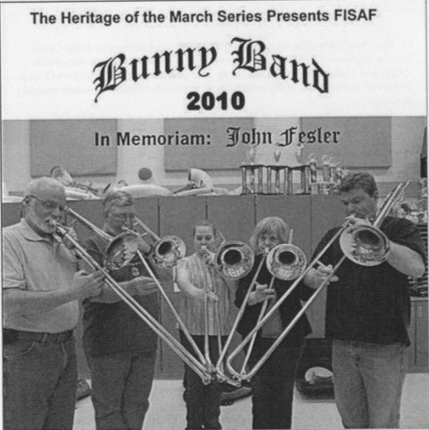
Figure 6. The 2010 cover of the HBM (or the FISAF or Bunny Band) featuring the trombone section and dedicated in memory of the tuba player, John Fesler, who played with the band for many years.
6. Special events (4): The HBM rarely performs publicly. Two public events, however, were recognized among memorable events: The Czech & Slovak Museum in Cedar Rapids, Iowa, and the Boone, Iowa, Municipal Band Festival. “Playing at the Cedar Rapids Czech Museum in the blazing heat with no shade,” is one memorable experience. “George is usually very strict on the correct tempo. But the longer we played, the faster the tempo became until we were flying through the marches!”
Closing Thoughts from the Musicians
The final question asked the respondents to “Share any other information or comments concerning the Bunny Band project or the experience that would be helpful in writing the history.” There were numerous comments, all meaningful and helpful. A few are shared here:
“Many of us [Illinois State University alumni] have stayed in touch because of the Bunny Band and the way our friendships morphed as we became adults and experienced our firsts together (first jobs, marriage, children, divorce, loss, career changes). We are still a source of support for of each other, all brought together by George Foeller and his music.”
“I was a member of Bob Hoe’s ‘Band Clan.’ Each shipment of records from Bob contained stories about how the records were made as well as some of Bob’s pontificating. I was still living in California at the time and I remember reading about the Bunny Band and feeling so jealous of the camaraderie Bob was describing. I was very excited to land a job in Iowa. That meant that I was now close enough to play in the Bunny Band. Now here it is years later and I’m actually hosting the band here in Maquoketa, Iowa. I cherish these experiences and these memories.”
“I find it interesting the generations that have participated in this endeavor—from students who became directors and then sent their students. I’ve enjoyed watching the personnel of the ensemble change over the years. More specifically as it moved from ISU to Fairbury [Illinois], to Chillicothe [Illinois] and now Maquoketa [Iowa]; however, the focus has remained the same—musically and socially.”
“What surprises many of the people around the world who purchase these recordings is the fact that this group performs together ONLY for one weekend each year. This is a testament to not only the musicianship of the performers, but also their dedication to making a quality recording.”
"The glue that keeps us all together is easy for us all to recognize and this is George Foeller. He is the one who pulls that style out of all of us and gives us that special sense of pride and accomplishment."
“The Bunny Band is a social group, meals all together or in small groups. George has a love of German food [and beer] which took us to Dubuque, Iowa, for a while then to Rock Island, Illinois, and the Bier Stube on Friday night after the rehearsal.”
“The feeling of accomplishment is a great feeling at the conclusion of the recording weekend. I leave very tired, and glad to go home, but look forward to the next time we are all together again.”
The Audio Archives
The comments offered from the survey provide a welcomed human touch to the experiences, sense of community, and spirit of the musicians. Their responses offer a personal history of the ensemble, and an appropriate backdrop to the 40-plus years of music making represented in the CMS Symposium’s Audio Archives of 44 albums of HBM performances. The history of the HBM ensemble and the testaments given by the musicians reinforces the compelling need to find a home for the some forty-plus years of time and talent given by Hoe, Foeller, and the musicians to maintain and expand this unique, international contribution to wind band music and its composers. For the first time, these recordings are archived, catalogued and made accessible for future listening and research through the CMS Symposium. And, in keeping with Robert Hoe’s wish, the archives through the support of The College Music Society, are free and accessible internationally to the online community.
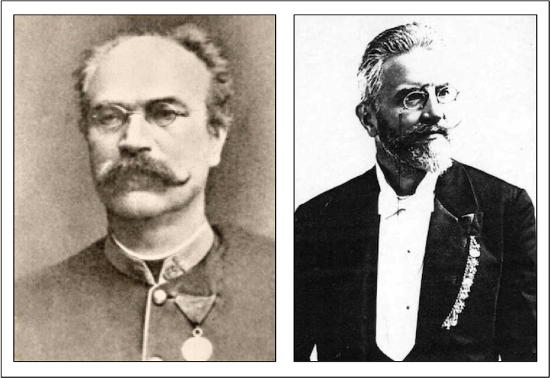
Figure 7a. Composers featured in HBM recordings: The Hungarian composers Karel Komzák (1823-1893) and his son, Karel Komzák II (1850-1905). The Komzák’s including the son of Komzák II were one of many families of composers for band music in the 19th century including the Strauss and the Lehár families. (Komzák I and Komzák II, public domain from Wikimedia)
The CMS Symposium Archive is the first completely digitized set of the HBM recordings. Like many of the Hoe recordings, the HBM recorded other music genres beyond the march, namely waltzes, overtures, Spanish paso dobles, and orchestral transcriptions. Along with the recordings are scans of the album covers with program notes. The album notes alone provide a rich resource of historical information on the music and the composers.
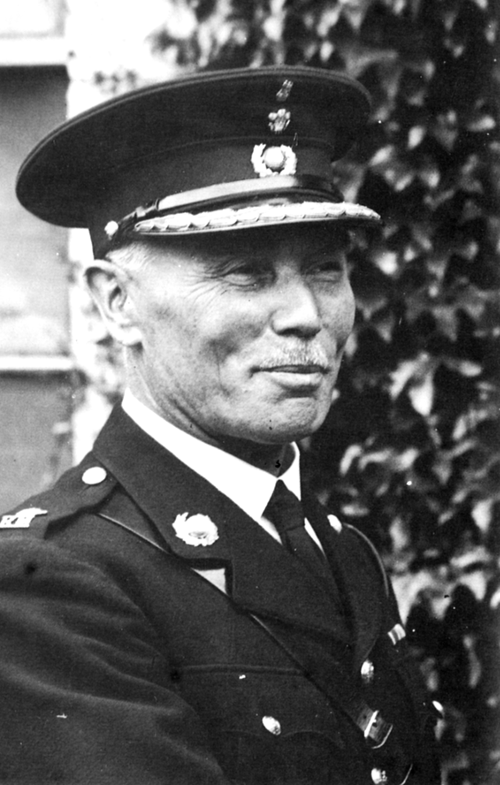
Figure 7b. Composers featured in HBM recordings: The British composer Frederick Joseph Ricketts who wrote under the name Kenneth J. Alford (1881-1945). (Public domain from Wikimedia.)
The international mix of band composers is extensive with a preponderance of European composers. A few examples include the following: American (Frank and Louis Pinella, David Wallace Reeves, W. Paris Chambers, Robert Browne Hall, Frank H. Losey, and Charles L. Barnhouse), Armenian (Aram Khachaturian), Austrian (Johann Fuchs, Karl Komzák, and the Strausses), Bohemian (Franz Kaschte), British (Kenneth J. Alford), Czech (Julius Fučík, Anton Rosenkranz), French (Louis-Luc Fersuis and Gabriel Pares), German (Hermann Blankenburg, Paul Lincke, and Georg Fürst), Italian (Salvatore Pucci, Tommaso Mario, and Mariano Bartolucci), Lithuanian (Bronius Jonusas), Moravian (Franz Lehár Jr. and Sr.), Norwegian (Rolf Lindstad, Willy Schikora), Romanian (losif Ivanovici), Russian (Semyon Tchernetsky, Vasily Soloviev-Sedoi), Slovakian (Rudolf Obruca), Spanish (Jaime Texidor, Luis Araque, Santiago Lope), Swiss (Gian Battista Mantegazzi), Uruguayian (Cayetano Silva). From the master list of recordings, there are some 79 unique Austro-Hungarian composers within the HBM collection.
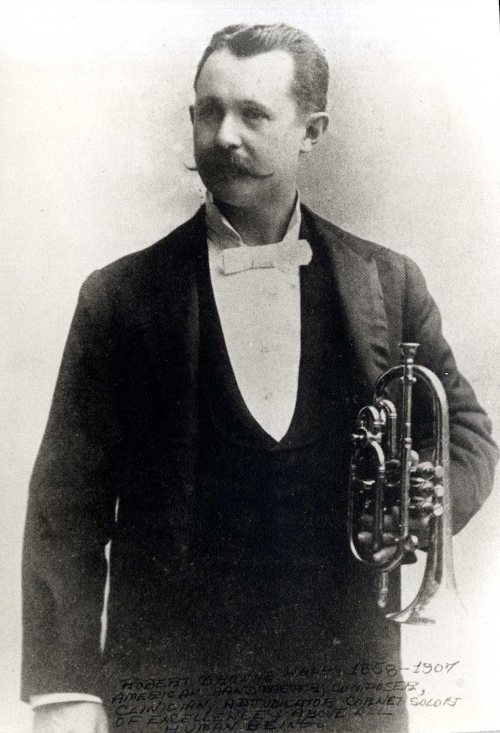
Figure 7c. Composers featured in HBM recordings: The American band leader and march composer, Robert Browne Hall, known as R.B. Hall, 1858-1907. (From the Thomas C. Bardwell Collection on R. B. Hall, University of Maine Digital Commons)
The HBM recordings are organized by year from 1974 to 2015. In some of the early Bob Hoe series recordings, two albums were produced in a year. The outline below indicates by year the album media type and the location of the recording sessions. The outline also indicates which albums were part of the original Hoe “Heritage of the March” recordings and the HBM albums that followed in the spirit of the Hoe heritage project. There are 44 albums in total in the archives.
• 1974 to 1977: 4 LP recordings with the Illinois State University Concert Band (From Hoe’s Lettered Series Albums D, H, K, V for 1974 to 1977 respectively)
• 1978 to 1985 with the FISAF Band (The Fairbury High School, Illinois, recordings)
⁃ 10 LP recordings with the Foeller’s Illinois State Alumni & Friends FISAF Band
⁃ Hoe’s Lettered Series: albums FF (1978) and EEE (1980)
- Hoe’s Numbered Series: albums 48 & 49 (1979), 56 (1980), 71 (1981), 77 & 78 (1982), 87 & 88 (1983).
⁃ 2 cassette recordings (1984 and 1985): FISAF Band on its own; no longer officially a part of the Hoe recording series.
• 1986 to 1999: FISAF Band (The Chillicothe High School, Illinois, recordings)
- 8 cassette recordings (1986-93)
⁃ No recordings (1994, 95, 97)
⁃ 3 CD recordings (1996, 98, 99)
• 2000 to 2015: FISAF Band (The Maquoketa High School, Iowa, recordings): 15 CDs
• Online compilations of selections from past recordings (2009 – 2015):
⁃ Heritage Band of the Midwest: Volume I (2011)
⁃ Heritage Band of the Midwest: Volume II (2011)
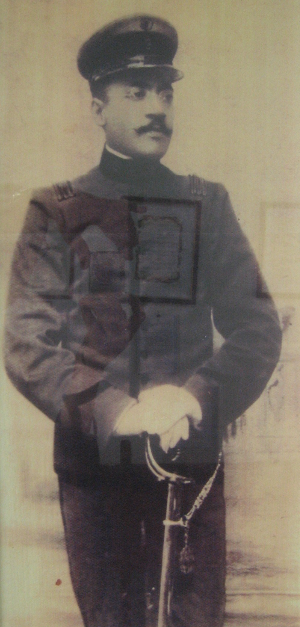
Figure 7d. Composers featured in HBM recordings: Cayetano Alberto Silva (1868-1920), Uruguayan musician and composer best known for his march “La Marcha San Lorenzo.” (Public domain from Wikipedia)
Master Index Page
- Complete Heritage Band of the Midwest audio archives (Large file to load; best option to search for titles or composers across all albums).
- Heritage Band of the Midwest: Band Music of Europe, Volumes 1 and 2
- Heritage Band of the Midwest LP recording years: 1974 - 1983
- Heritage Band of the Midwest Cassette recording years: 1984 - 1993
- Heritage Band of the Midwest CD recording years: 1994 - 2015
Note: All of the recordings in the HBM audio archives are performed from arrangements by George Foeller, the Director, or friends of the Director. The arrangements are unpublished. To the best of Professor Foeller’s knowledge the music is free of copyright given the age of the composers. In the spirit of the Heritage Band of the Midwest dating back to Robert “Bob” Hoe, all recordings are distributed free. Should a composer or publisher identify a work that is under copyright and not available for public dissemination, please notify us and the audio recording will be removed from the archives.
Acknowledgments
The complexity of compiling the 40-plus year history and recordings for the Heritage Band of the Midwest cannot be overstated. It has been a team effort and a labor of love. Recognition goes to HBM players Fred Lange (trombone with HSM since 1974) and Dan Weil (euphonium since 2010) for their help in assisting with digitizing LPs, cassettes, and CD discs for the HBM Albums. Dr. James Parr (tuba since 1987) came to our rescue in helping to edit the master list of albums, music titles, and composers; given the extensive foreign origins of much of the music, dealing with issues like the diacritical markings was a tedious but important task. He was assisted by Jane Wilson, a Czech language consultant. Thanks also to the current and past members of the Bunny Band that took time to respond to the survey and share their experiences. And, finally, thanks to Professor George Foeller for always being available to answer questions, share various moments in the band’s history, and dig into his archive of materials to retrieve key information. On behalf of all the musicians who have volunteered their time and talents to the HBM ensemble, a profound expression of appreciation to George Foeller for his musicianship, research, leadership, and dedication in making this unique project possible.
Notes
1George Foeller, "Conversations and Correspondence,” unpublished interviews by the author, 2014 – 2016. Throughout the research and writing of this article, the author was in close contact with Professor Foeller to ensure the accuracy of the history of the Heritage Band of the Midwest.
2The Symposium “Audio Performance Archive,” http://symposium.music.org
3Jeremy Grimshaw, “Eastman Wind Ensemble.”
4“Milestones in Wind Ensemble History.”
5Manufacturers Index, “R. Hoe & Co.”
6Arthur Bradley, "Heritage of the March,” 169.
7Jay Kahn, “The Last ‘Heritage of the March’ Band,” 71.
8Ibid.
9Arthur Bradley, “Heritage of the March” 171.
10Ibid, 175.
11“The Legacy of Robert Hoe, Jr.”
12Arthur Bradley, “Heritage of the March,” 181.
13William H. Rehig, et al., The Heritage Encyclopedia of Band Music.
14The Hoe Heritage Series of LP Records.
15“Robert Hoe Collection,” ArchivesUM. The Robert Hoe Collection contains 189 LP recordings (plus duplicates) of American and European band marches, including the Heritage of the March series and a set of Sousa’s works recorded by the United States Marine Band. The collection also contains 18 of Robert Hoe’s newsletters
16Arthur Bradley, “Heritage of the March.”
17Phi Beta Mu website biography, “George Foeller.”
18Jay Kahn, “The Last ‘Heritage of the March’ Band,” 71.
19George Foeller and Werner Probst, Bands of the Austro-Hungarian Empire.
20Arthur Bradley, “Heritage of the March,” 177.
21George Foeller, “Conversations and Correspondence.”
22Jay Kahn, “The Last ‘Heritage of the March’ Band,” 71
23George Foeller, “Conversations and Correspondence.” Ibid.
24Ibid.
25Ibid.
26The author and his wife, Kay Williams, began playing clarinet with the HBM in 2008.
27Hosted Survey, http://www.hostedsurvey.com.
Bibliography
Bradley, Arthur. “Heritage of the March.” In On and Off the Bandstand, 169-90. New York: IUniverse, 2005.
Foeller, George. “Conversations and Correspondence.” Personal interviews by David Brian Williams. Bloomington, IL, 2014-2016: Unpublished.
Foeller, George, and Werner Probst. Bands of the Austro-Hungarian Empire: A Reference Work for the Concerned American Band Musician. Normal: Printed by G. Foeller, 1987.
"George Foeller. Phi Beta Mu Website Biography". Last modified, 1997. Accessed September 23, 2016. http://phibetamuxi.org/Phi_Beta_Mu/Foeller.html.
Grimshaw, Jeremy. “Eastman Wind Ensemble: Artist Biography.” AllMusic. Accessed September 21, 2016. http://www.allmusic.com/artist/eastman-wind-ensemble-mn0000587245/biography.
"Heritage of the March.” Wikipedia. Accessed September 9, 2016. https://en.wikipedia.org/wiki/Heritage_of_the_March.
Kahn, Jay. “The Last ‘Heritage of the March’ Band: The Bunny Band Continues to Hop Merrily Along.” Band International 33, no. 2 (2011): 71-72.
Kahn, Jay. “Maquoketa Hosts ‘Heritage of the March’ Project,” Maquoketa Sentinel-Press, August 1, 2001.
"Milestones in Wind Ensemble History.” Eastman Wind Ensemble. Accessed September 21, 2016. http://www.esm.rochester.edu/ewe/milestones.php.
Manufacturers Index – "R. Hoe & Co.” Vintage Machinery. Accessed September 25, 2016. http://www.vintagemachinery.org/mfgindex/detail.aspx?id=1670&tab=0
Rehrig, William H., Paul E. Bierley, and Robert Hoe. The Heritage Encyclopedia of Band Music: Composers and Their Music. Vol. 1-3. Westerville, OH: Integrity, 1991. Print.
"Robert Hoe Collection.” ArchivesUM: University of Maryland Libraries Digital Collections. Accessed September 21, 2016. http://hdl.handle.net/1903.1/19199.
"Robert Hoe, Jr., Benefactor.” Heritage Encyclopedia of Band Music. Accessed September 9, 2016. http://hebm.info/AboutUs/Contributors.aspx.
"The Hoe Heritage Series of LP Records.” Heritage Encyclopedia of Band Music. Accessed September 21, 2016. http://hebm.info/AboutUs/TheHoeSeriesOfRecordings.aspx.
"The Legacy of Robert Hoe, Jr.” Heritage Encyclopedia of Band Music. Accessed September 9, 2016. http://hebm.info/AboutUs/TheLegacyOfRobertHoe.aspx.


